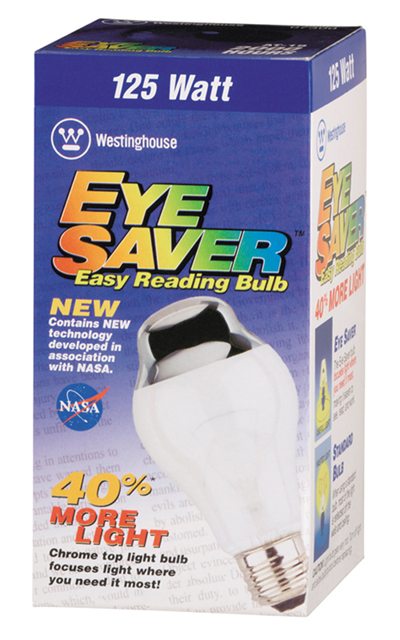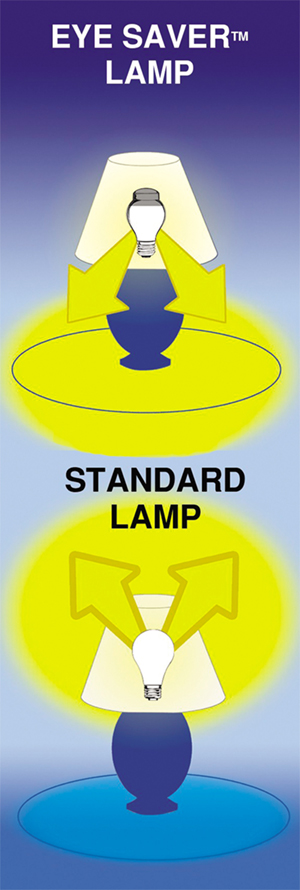A Bright Idea for the Eyes
Originating Technology/ NASA Contribution
Throughout its existence, NASA has made many amazing discoveries in the field of optics that have led to improved eye care and eye wear applications on Earth. Innovations such as laser eye-tracking for LASIK vision-correction procedures, eye trackers that enable people with severe disabilities to communicate and control their environment using only their eye movements, and scratch-resistant and radiation-blocking lenses are just a taste of the Space Agency’s optical accomplishments.
In 2003, the world feasted its eyes on yet another optical offspring of NASA research: Westinghouse Lighting Corporation’s Eye Saver™ Easy Reading Light Bulb. Over 2 years in the making, the Eye Saver bulb got its start when Barton Pasternak, executive vice president of Philadelphia-based Westinghouse Lighting Corporation, recognized a need to concentrate more light onto a work surface. Pasternak began working on a reflective insert for lamp shades, but quickly realized that optimum work space lighting could be attained with a light bulb. He and friend, Dr. Forrest Marshall, O.D., the chief executive officer of medical product developer Marshall Research, LLC, worked on ideas for innovative light bulbs that would make seeing easier under working conditions. To develop these ideas further, Dr. Scott Smith of NASA was brought in to apply his knowledge of deep space telescope optics to what would eventually become the Eye Saver bulb.
Partnership
As director of NASA’s Space Optics Manufacturing Technology Center at Marshall Space Flight Center, Smith provides the leadership and direction required for research, design, development, fabrication, metrology, and testing of in-flight optical systems. Smith and his space optics center colleagues were introduced to Westinghouse Lighting Corporation by Ben Franklin Technology Partners, a Pennsylvania network that helps local companies develop new products to stimulate the state’s economic growth. Together, Smith’s team and members of Westinghouse Lighting Corporation, including Pasternak and Marshall, created a design for a light bulb consisting of a chrome top that would direct light to areas where it is needed most. By determining various angle degrees for the chrome top (critical to enhancing light) and studying different light sources and bulb shapes, Smith and his NASA colleagues were instrumental in producing the ideal design for the product.
Product Outcome
Available in 125-Watt and 3-way (50/125/175-Watt) models, the Eye Saver light bulb provides 40 percent more surface illumination on work and reading surfaces, compared to a standard incandescent light bulb, and possesses a lightly frosted finish that reduces eyestrain by diminishing glare. Additionally, the Eye Saver lasts 2,000 hours, twice as long as a standard incandescent bulb. The product is suitable for people of all ages and is particularly ideal for applications requiring high light levels, like reading, sewing, crafts, and numerous other recreational hobbies.
Notably, the light bulb helps those with macular degeneration and low vision to see easier in performing tasks that might otherwise prove daunting due to their conditions, especially seniors, who are most susceptible to these eye diseases. Age-related macular degeneration is the number one cause of vision loss and legal blindness in American adults over the age of 60, according to a non-profit organization known as the Macular Degeneration Partnership. Juveniles affected by macular degeneration and low vision also benefit from the Eye Saver bulb’s ability to improve visual performance.
The practicality of Westinghouse Lighting Corporation’s Eye Saver technology falls in line with recommendations made by Rensselaer Polytechnic Institute’s Lighting Research Center, the world’s largest university-based center for lighting education and research. According to the Lighting Research Center, placing light fixtures close to a task area and selecting bulbs with a high number of lumens or a strong light output is one of the best ways to combat the effects of low vision.
Furthermore, the Discovery Fund for Eye Research recognizes the Eye Saver as a useful light source for those who need enhanced lighting due to eye disease. Westinghouse Lighting Corporation donates a portion of its proceeds from the sale of each Eye Saver bulb to the Discovery Fund for Eye Research. The bulb retails from $8.99 to $11.99 and can be purchased through eye care professionals all around the country, or through select distributors and retailers such as Stormin’ Norman’s Discount Optics, Meijer Vision Centers, Boscov’s, Carson Pirie Scott, JCPenney, and Sears.
Meanwhile, Westinghouse Lighting Corporation is continuing to develop professional optical products with the help it has received from NASA and further guidance from Marshall Research, LLC. In the works is a portable lamp attachment which uses a special bulb and motorized focus to develop intense, no-glare light for the severely visually impaired.
Marshall Space Flight Center’s Space Optics Manufacturing Technology Center supports NASA’s Science, Aeronautics Research, and Exploration Systems Mission Directorates. The optics center has been responsible for testing and calibrating the Chandra X-ray Observatory, the world’s most powerful X-ray telescope, and is currently testing a new, advanced mirror system for the James Webb Space Telescope, the successor to the Hubble Space Telescope.
Eye Saver™ is a trademark of Westinghouse Lighting Corporation.

Westinghouse Lighting Corporation’s Eye Saver™ Easy Reading Light Bulb is available in 125-Watt and 3-way (50/125/175-Watt) models.

The Eye Saver™ directs light to areas where it is needed most, whereas a standard light bulb reflects a majority of the light off of walls and the ceiling.













